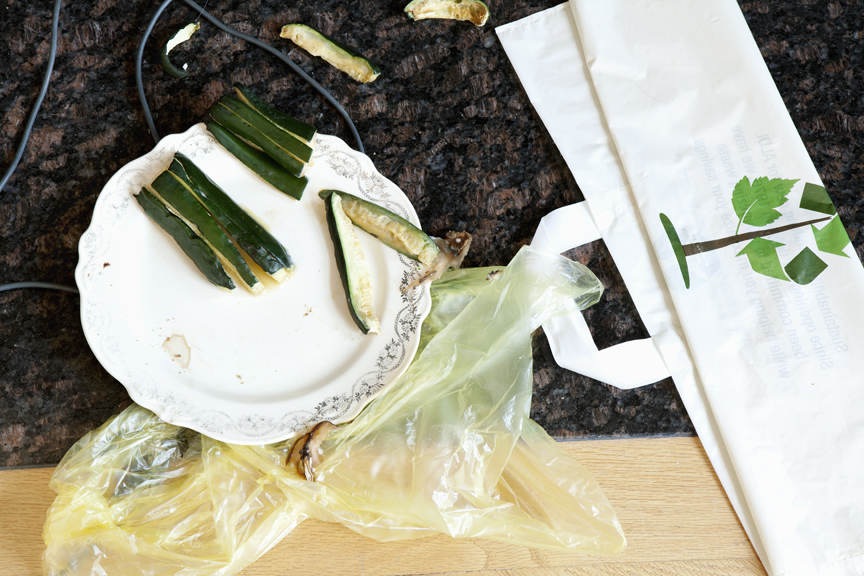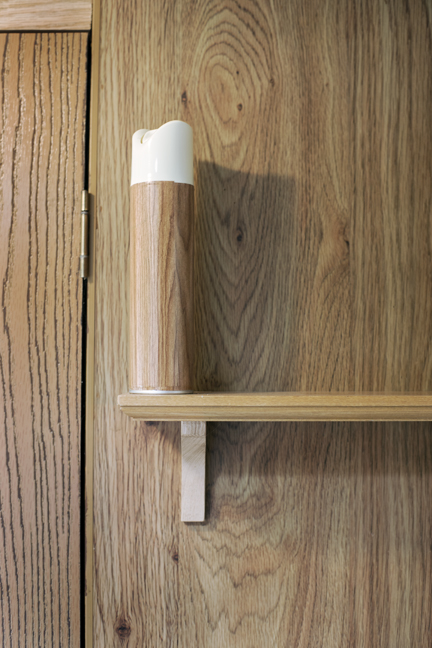

March
Archival Inkjet Print
2013
I spend a lot of time looking at the ground for treasure. Some of my most cherished possessions include a broken umbrella handle found in New York City near 2nd Avenue and 9th Street; a discarded bathroom tile from midtown Detroit; a slip of paper with the inscription: “Motformin Crestor Vitamina B12 90 Dias Supply” found near New Haven’s Grand Central Station; and a Parliament cigarette butt emblazoned with hot pink lip stain, picked up near the intersection of Wabash and Van Buren in the Chicago Loop.
My prized possessions gain new meaning beyond the politics of trash.
I treasure an array of expendable materials found in domestic spaces, like plastic packaging, single-use supplies, laundry lint, food waste, and accumulations of human hair and fingernails.
Collecting consumed objects from my apartment and city streets, I construct photographic still-lifes to explore the infinitely varied roles, forms, placements, uses and colors of banal, often ephemeral, sometimes grotesque, and occasionally magical, humdrum substances. The act of collecting gives my material a new story; elevated and fragmented within the photographic frame, my prized possessions gain new meaning beyond the politics of trash.
Artifacts, once mundane and grotesque, mutate into unique and priceless relics that carry testimony to marvel. The mysteries of these items speak to the self-referential, fetishistic impulse to collect, an impulse unfettered by sentimentality or gaps in perception. There is tension between what is known of the objects and what a collector wishes to reveal. By pairing the collection of ephemeral materials with the creative process, the artist-collector re-invents the mundane and sometimes repulsive aspects of refuse through a series of poetic exchanges.


Possessions 1 and 2
Archival Inkjet Print
2012


Possessions 6-12
Archival Inkjet Print
2013


Unknown Possessions
Archival Inkjet Print
2013
By pairing the collection of ephemeral materials with the creative process, the artist-collector re-invents the mundane and sometimes repulsive aspects of refuse through a series of poetic exchanges.
In any collection, there is a division between what is known of the materials and what the collector wishes to emphasize. In my pursuits, the object is enhanced through a studio practice that allows viewers to see the material for its connotative power beyond what it commonly and casually represents. As the collector, I become the custodian of discarded objects that have lost their value in the dominant culture; my re-valuation establishes renewed meaning.
The poetic exchange is a trial and error of three steps: first, the idiosyncratic and selective act of collection; second, the rigorous re-contextualization through construction and fragmentation in the studio; and third, the final presentation, in which the photograph formalizes, compresses and flattens the objects within the frame. The visual language of photography transforms the banal content, endowing the degraded arrangements with meaning as they are flattened and bathed in soft light that amplifies complex geometries, colors and textures.


Unknown Possessions 2
Archival Inkjet Print
2013
The process of collection figures crucially in my practice, but it is not communicated in the presentation of a still photograph. The need to acquire for the sake of acquiring rather than out of necessity nods to the culture of Cabinets of Curiosities, a 16th century practice of displaying eclectic acquisitions. These collectors were preoccupied or obsessed with creating a living record of the natural world, and at times their collections suggest evidence of a supernatural world pieced together by assembling the rare and novel, separate from any functional or utilitarian value.


Mouse River Park
Archival Inkjet Print
2012
My process of recontextualizing and reclassifying obsolescent items creates a new genre by exploring the curiosities of refuse and its poetic resonances, suggesting ubiquitous articles should be experienced as rare and novel. The final and carefully considered display of my accumulations — what I have named a Cabinet of Banalities — emphasizes the formal qualities of refuse, divorcing it from its usual dismissal as trash. Taken from the democratic forest, abject content is recharged by the idiosyncratic culture of collecting. When merged with rigorous studio practice and creative representation, mundane encounters are transformed into exquisite engagement.
Wherever an object’s value falls on the cultural barometer, the context of its presentation alters its ascribed meaning. Deciphering the messages that objects communicate requires acknowledging the limits of what can be known with certainty. We must consider a different kind of knowing in order to expand our understanding of what can be admired and preserved, or used, broken and thrown away.


Possession 14, Archival Inkjet Print, 2013
Musings on Alchemy, Archival Inkjet Print, 2013
Styrofoam Egg Crate, 12 Used Tissues, Balsa Wood Kick Stand, Archival Inkjet Print, 2012